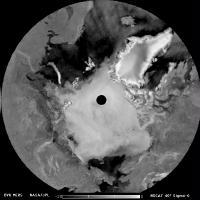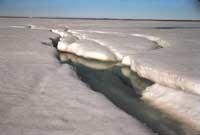Component of the soybean plant to reduce fuel
2000/04/11 Roa Zubia, Guillermo - Elhuyar Zientzia

An automatic station will be located in the North Pole which will study the influence of the sea in the general climate. Because there is only ice floating in this territory, research buoys and equipment connected to the background will also be used.
This month a group of international researchers will build the station with the support of the National Science Foundation (NSF). A project for five years is announced. The main objectives are to study the cycles of the pole and the contribution of the sea in the field of climatology.
The team will be led by James Morison, of the University of Washington. As he explained, during this spring, the group will open a system of buoys and, perhaps, devices that have been incorporated into the seabed to collect all kinds of data. Among other things, water salinity and the thickness and temperature of the ice layer will be measured. «For the first time the system of unconsolidated buoy in the North Pole will be in the sea».
Space for general science
Therefore, the buoys will be adrift. During some seasons, researchers will return to the North Pole to release more buoys. The NSF researcher, Michael Ledbetter, believes that within a year projects from many scientific fields will be launched. Morison stressed that long-term observations will be made and accumulated in an automated station without humans, which will be much cheaper than that of workers.
The data collected for a long time in the North Pole already reflect the importance of the Arctic in climate regulation. In the observations one can appreciate the decrease of the ice layer, the changes in the fast waters and its great influence on the Arctic Ocean. These effects are related to changes in atmospheric circulation in the Northern Hemisphere. This circulation is called «Arctic oscillation» and is centered in the North Pole.
In the opinion of Ledbetter, the traffic of the Arctic Ocean and the water flowing from the Arctic to the Sea of Greenland affects the investment of traffic in depth. Therefore, it must also influence the control of the climate.
The NSF has contributed more than $5 million to Morison's research team to work for five years. Not only should members of the University of Washington participate this year. For the time being, researchers at Oregon State University, the Seattle Pacifist Marine Environment Laboratory, the Japan Sea Science and Technology Center, and the Canadian Met-Ocean Corp will work in the coming months.
Morison said the team would leave for the North Pole in the first days of April and release the first buoys. The variables that will begin to be measured shortly are atmospheric pressure, temperature, wind, solar radiation, water temperature, salinity, the profile of the temperature of the ice and the thickness of the ice layer. The buoys are expected to float with the ice layer for next year, due to their availability, and they can reach the Sea of Greenland.
Another important aspect underlined by Morison is that the North Pole is far from any terrestrial dryer and any station. Even with submarine boats and icebreaker ships, it is very difficult to obtain data on temperature measurements at the pole for long periods of time, for example. These floating «stations» have been designed to work for a long time and in a wide geographical area. In the future, measurements will be multiplied thanks to the background instruments. In addition, the new American vessel Cutter Healy, dedicated to breaking scientific ice, will participate in the launch of buoys.
"This station will fill the gap of scientific observations," said Morison. "The data sets that this and other similar stations will provide us with will be key benchmarks in the research work on climate change."
Monitoring of what has already begun
With the launch of the North Pole station, the polar research office of the NSF will have working areas at the two poles of the Earth. The American Antarctic program already has three stations that work throughout the year. Perhaps the most famous is the South Pole station of Admunsen-Scott. However, for the moment it is impossible to carry out an investigation similar to that which is in progress, since the North Pole is only an ice that floats in the sea. This "zone" is changing and has a high risk of being isolated.

Gai honi buruzko eduki gehiago
Elhuyarrek garatutako teknologia






